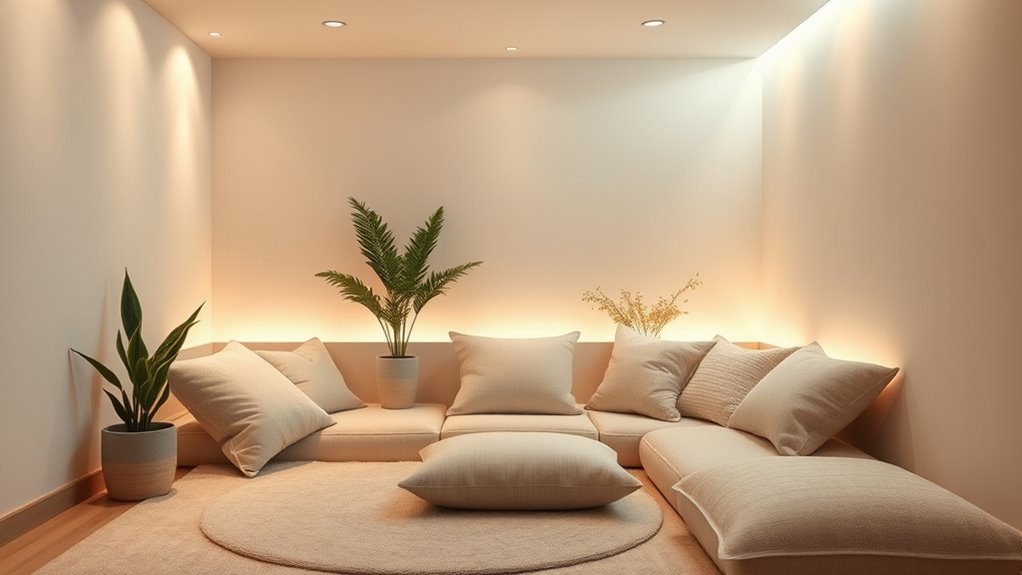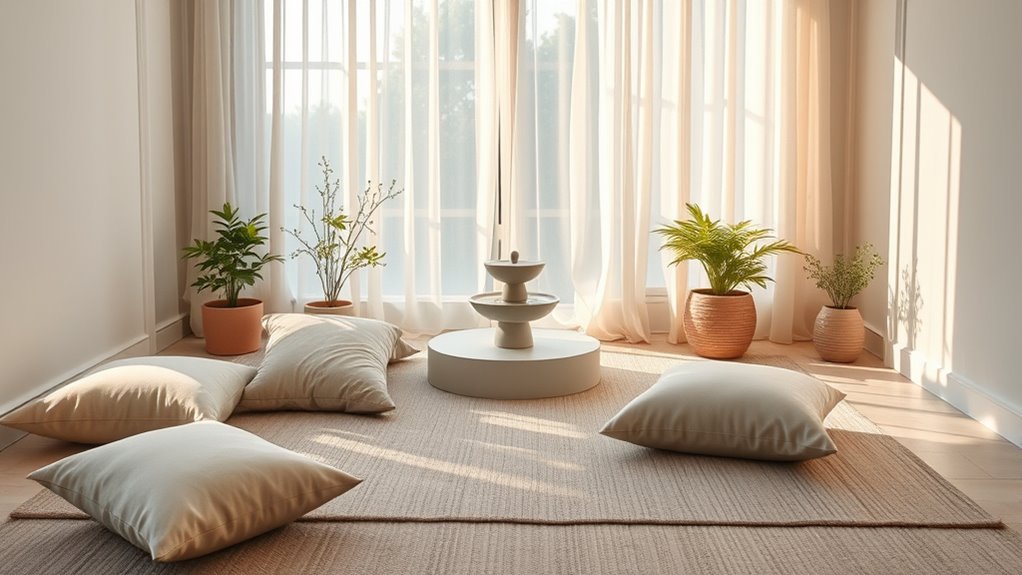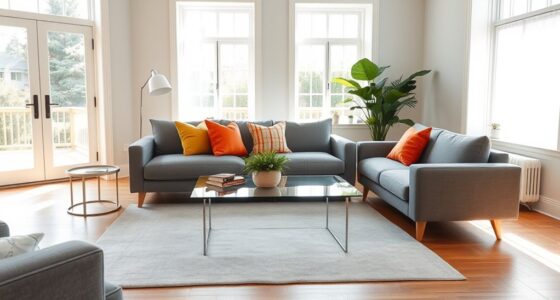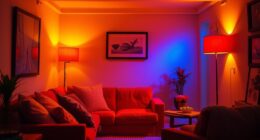To create calm spaces that prevent sensory overload for neurodivergent minds, focus on gentle lighting like warm LEDs with adjustable brightness and layered options, which let you control intensity and avoid harsh glare. Incorporate soft textures, plush cushions, and natural elements to provide tactile comfort without overwhelming visuals. Keep the environment clutter-free with simple colors and patterns, and include quiet zones for retreat. If you explore these strategies further, you’ll discover how to build truly soothing spaces.
Key Takeaways
- Use soft, diffused lighting with adjustable brightness to create a calming, non-overstimulating environment.
- Incorporate textured tactile elements like plush cushions or wall panels to offer soothing sensory input.
- Design clutter-free spaces with minimal visual stimuli and calming colors to prevent overstimulation.
- Include quiet zones or cozy corners as retreats for sensory regulation and relaxation.
- Integrate natural elements such as plants and wooden decor to promote a peaceful, organic atmosphere.

Have you ever felt overwhelmed by too many sights, sounds, or sensations all at once? If so, you’re not alone. For many neurodivergent individuals, everyday environments can become overwhelming quickly, leading to sensory overload. But the good news is, you can design spaces that help ease these feelings by carefully considering elements like mindful lighting and textured surfaces. These small adjustments can make a significant difference in creating calming environments that cater to sensitive minds.
Mindful lighting plays a crucial role in reducing overstimulation. Bright, harsh lights can make a space feel chaotic, while soft, diffused lighting creates a gentle ambiance that promotes relaxation. Instead of fluorescent bulbs, opt for warm LED lights with adjustable brightness so you can tailor the environment to your needs. Natural light is also beneficial; large windows or skylights allow sunlight to fill the room, but you can soften its impact with sheer curtains. Dimming options and layered lighting—such as lamps, sconces, or indirect fixtures—offer control over how much light enters, helping you avoid sudden brightness changes that can trigger sensory overload. Additionally, choosing appropriate projector technology can enhance visual comfort by reducing glare and optimizing image quality, further supporting a calming environment.
Another powerful way to create a calming space is through textured surfaces. Smooth, uniform walls and furniture may seem minimalistic, but incorporating textured surfaces adds sensory interest without overwhelming. Think about using soft textiles like plush cushions, rugs, or blankets that invite touch and provide gentle feedback. These tactile elements can ground you in the space, offering comfort through physical sensation. You might also consider textured wall panels or artwork with varied surfaces—these can serve as focal points that don’t demand too much attention but still add depth and interest. The key is balancing tactile variety with simplicity, avoiding clutter that can intensify sensory input.
When designing for sensory regulation, it’s important to remember that less often equals more. Keep visual stimuli minimal—choose calming colors and simple patterns, steering clear of busy prints or vibrant hues that can be overstimulating. Maintain a clutter-free environment to prevent sensory chaos, and include cozy corners or quiet zones where you can retreat if things become too much. Incorporate natural elements like plants or wooden decor to introduce organic textures and a sense of calm.
Frequently Asked Questions
How Can I Identify if Someone Is Experiencing Sensory Overload?
You can spot if someone’s experiencing sensory overload by watching for visual cues like covering their ears, avoiding eye contact, or covering their face. Behavioral indicators include fidgeting, withdrawing, or becoming irritable. Pay attention to these signs, and if you notice them, gently ask if they need a break or a quieter space. Recognizing these cues helps you support them before they become overwhelmed.
What Are Common Signs of Sensory Overload in Children?
You might notice sensory overload in children through signs like covering their ears, avoiding eye contact, or becoming overwhelmed by noise and bright lights. They may also exhibit behaviors such as tantrums, withdrawal, or difficulty focusing. Recognizing sensory triggers helps you implement effective coping strategies, such as creating calm spaces or reducing stimulation, so children can feel more comfortable and manage their reactions better.
Are There Specific Colors That Help Reduce Sensory Overload?
Did you know that colors influence mood and calmness? Using calming palettes, such as soft blues, gentle greens, and muted neutrals, can help reduce sensory overload. Color psychology shows these hues promote relaxation and focus. When designing spaces, choose these soothing shades to create an environment that feels safe and tranquil, helping neurodivergent minds feel more comfortable and less overwhelmed.
How Long Should a Calming Space Be Maintained for Neurodivergent Individuals?
You should monitor the duration neurodivergent individuals spend in a calming space to prevent overstimulation or withdrawal. Typically, 10-15 minutes works well, but it varies based on individual needs. Use space customization to adjust the environment for comfort, and regularly check in to gauge their response. By actively managing the time and tailoring the space, you help guarantee the calming effect remains effective and supportive.
Can Sensory Overload Affect Mental Health Long-Term?
You might wonder if sensory overload impacts mental health long-term. It can, especially if sensory processing issues persist without environmental adaptation. Prolonged overload may lead to anxiety, stress, or burnout. By creating calm spaces that address sensory needs, you help reduce overload and support mental well-being. Recognizing sensory processing challenges and implementing environmental adaptations are key to preventing long-term mental health effects for neurodivergent individuals.
Conclusion
By designing calm, sensory-friendly spaces, you create environments where neurodivergent minds can thrive. Imagine a school installing soft lighting, quiet zones, and textured seating—students like Jamie, who previously struggled with overstimulation, now find focus and comfort. Your thoughtful touches make a real difference, transforming chaos into calm. So, when you prioritize sensory considerations, you’re not just designing rooms—you’re fostering confidence, understanding, and well-being for everyone who enters.









